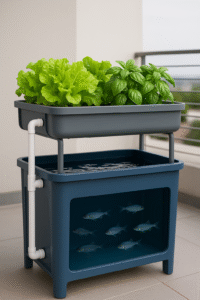Sunlight — The Most Crucial Factor for Plant Growth
- Fruiting vegetables (tomatoes, peppers, cucumbers) need 6 + h of direct sun daily.
- Leafy greens (lettuce, kale, herbs) require only 4–6 h.
- Checklist: Which direction does the balcony face? (South-facing in the Northern Hemisphere; north-facing in the Southern Hemisphere is ideal.)
- Track actual sunlight hours for several days; ensure light reaches the grow-bed level, not just the railing.
- Low-light solution: Focus on greens/herbs or add LED grow lights.
Weight Capacity — Critical Safety Issue!
- Water is heavy: 1 gal ≈ 8.3 lb / 3.8 kg. Even a small 50-gal tank plus grow bed can exceed 700 lb / 318 kg.
- Verify the balcony’s rated load (ask your landlord, property manager, or consult building plans).
- Never guess; overloading can cause structural failure.
- Solutions: Use lighter, shallower tanks (20–40 gal), wide shallow grow beds, lighter media (NFT/DWC), and distribute weight over beams.
Climate & Weather Exposure
- Balconies experience greater temperature swings than indoors.
- Select fish tolerant of local temperatures (e.g., koi/goldfish in cooler climates; tilapia in warm regions).
- Mitigate wind with trellises or shade cloth; insulate tanks; provide heaters/chillers if needed.
Space & Layout
- Measure carefully: allow room for tanks, grow beds, sump, plumbing and maintenance access.
- Use vertical integration: shelving, stacked systems, wall-mounted channels.
Water Access & Drainage
- Plan easy water top-ups (hose or storage container).
- Ensure overflow drains safely into a floor drain or catchment container — never onto neighbors below.
Electricity & Noise Considerations
- Use outdoor-rated GFCI outlets for pumps/air stones.
- Select quiet pumps; return water below surface to reduce splashing noise.
Building Rules & Neighbor Relations
- Check HOA / strata / lease agreements — some forbid water features or large tanks.
- Communicate with neighbors about potential noise, water mist, or aesthetics.
2. Advantages of Balcony Aquaponics
- Makes productive use of under-utilized urban space.
- Typically better sunlight than indoor setups.
- Fresh air improves plant health; fewer ground pests.
- Creates a pleasant green retreat right outside your door.
3. Recommended Balcony System Setup
- Start small: 20–40 gal tank + single media bed.
- Prioritize safety: verify weight capacity and drainage.
- Choose hardy species: goldfish or hardy ornamentals; focus on leafy greens, herbs, strawberries.
- Plan easy maintenance access & use commercial balcony kits if available.
4. Final Checklist
Before building a balcony aquaponics system, confirm:
- Sunlight: ≥ 4–6 h for greens, ≥ 6 h for fruiting crops.
- Weight capacity: Balcony can safely support the total load.
- Climate: Temperature range suitable for fish & plants.
- Space & drainage: Adequate layout and safe overflow management.
- Rules: Building regulations allow water systems and fish tanks.
If all boxes are ticked, your balcony can become a thriving aquaponics oasis. Start small, emphasize safety, and enjoy fresh produce steps away from your living room!

